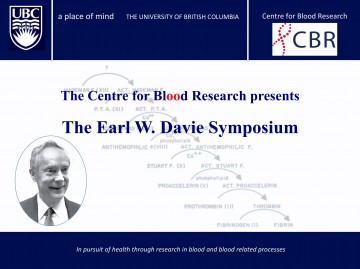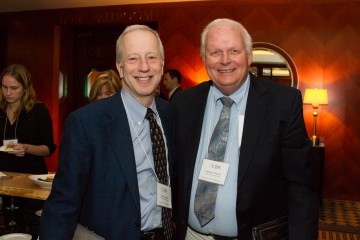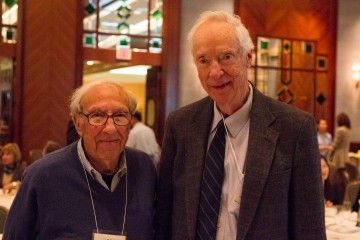November 13, 2012 marked the 6th Annual Earl W. Davie Symposium, hosted by the CBR and sponsored by Novo Nordisk. It was a memorable event, with over 200 attendees, a range of entertaining and stimulating speakers, excellent posters, delicious food and fine wine.
 Arguably, one of the major discoveries in medicine in the latter half of the 20th century was made by Dr. Earl Davie who, in 1964, proposed the waterfall sequence for blood clotting. Although our understanding of the biochemical events surrounding coagulation has evolved since then, the major concepts have been and continue to be the basis for currently used diagnostic tests and therapies, in coagulation and in other diseases. The impact of Dr. Davie’s work is indeed, immeasurable, and we are grateful to have the opportunity to honour him each year with this annual symposium that carries his name.
Arguably, one of the major discoveries in medicine in the latter half of the 20th century was made by Dr. Earl Davie who, in 1964, proposed the waterfall sequence for blood clotting. Although our understanding of the biochemical events surrounding coagulation has evolved since then, the major concepts have been and continue to be the basis for currently used diagnostic tests and therapies, in coagulation and in other diseases. The impact of Dr. Davie’s work is indeed, immeasurable, and we are grateful to have the opportunity to honour him each year with this annual symposium that carries his name.
This year, we had two keynote speakers, Dr. Charles Esmon from Oklahoma, and Dr. David Ginsburg from Michigan. Both are world-renowned investigators and Howard Hughes Scientists. They expanded our knowledge base in clinical and fundamental aspects of the regulation of coagulation and demonstrated how this system interfaces with other biological processes, including in particular, inflammation and infection. In addition, Dr. Diane Nugent came from UC Irvine to share her expertise in inherited bleeding disorders. Dr. Hugh Kim, who will join the CBR in January, visited from Harvard to discuss how the platelet cytoskeleton regulates inflammation, and Dr. José Lopez, a regular from Puget Sound Blood Center in Seattle, presented incredible images of how von Willebrand factor self-associates into long strands that alters its function.
We were also fortunate to have a strong representation of local speakers. Dr. Shannon Jackson kicked off the meeting with new insights into how to manage patients with hemophilia with prophylactic regimens. Tyler Smith highlighted the challenges of monitoring the new oral anticoagulants in the lab. Mike Krisinger revealed novel biochemical pathways that link coagulation and innate immunity, and Dr. Chris Overall provided a systems approach to untangling the complex effects of metalloproteinases. In the afternoon, Michael Hughes gave a fresh look at the properties of neutrophils in inflammation and Ashley Hilchie introduced us to the powers of immunomodulatory peptides. The ever-popular shot-gun poster talks by our many students and staff, as usual, were a big hit and set the stage for stimulating discussions at the poster sessions.
Finally, we were honoured that Dr. Edmond Fischer, from the University of Washington and a longtime friend and colleague of Dr. Davie, could attend. Dr. Fischer, with Dr. Ed Krebs, received the Nobel Prize for Physiology or Medicine in 1992 for their discovery of reversible protein phosphorylation. Dr. Fischer was so impressed with this year’s symposium, that he has promised to return to give a lecture on the history and impact of protein phosphorylation!
Overall, it was a great event. Dr. Davie and his wife Anita, are already planning their next trip to Vancouver for November 2013!
For other links that describe the Earl Davie Symposium and to see more pictures, go to the CBR Facebook page, check out this new CBR Blog, and/or go to the UBC FoM homepage.





Comments are closed, but trackbacks and pingbacks are open.